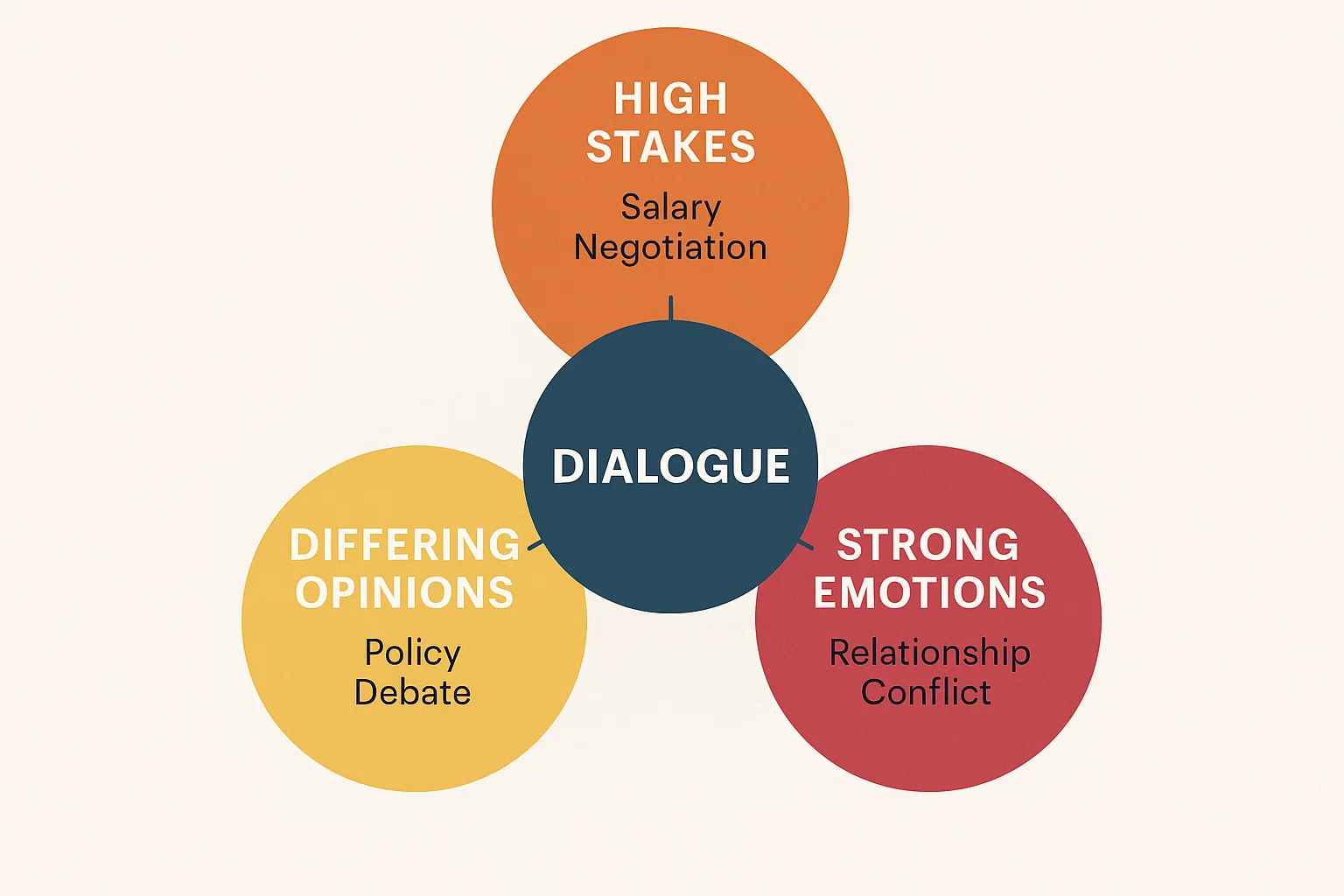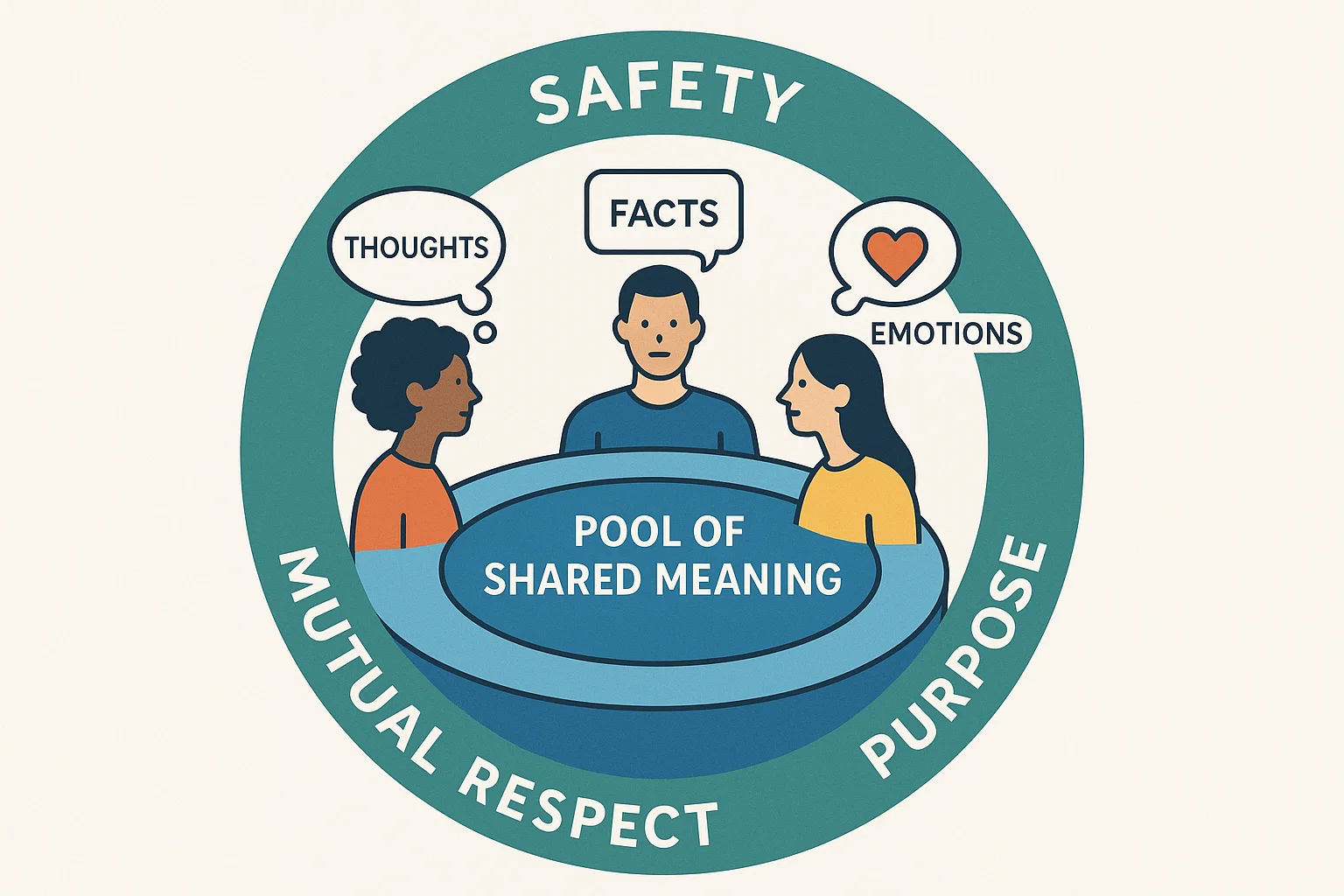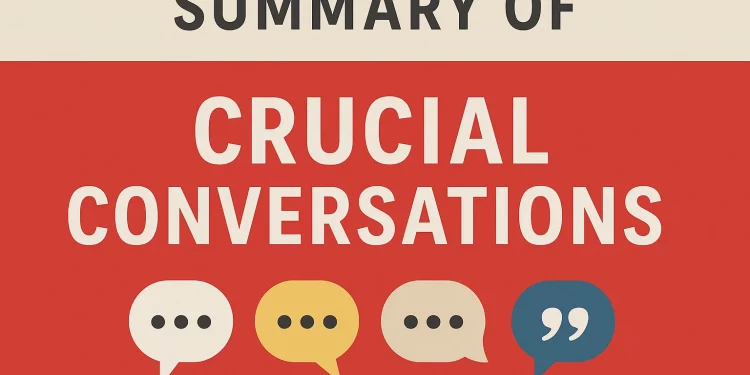Introduction
Ever found yourself in a conversation where your heart races, your hands sweat, and the outcome could change everything? That’s what authors Kerry Patterson, Joseph Grenny, Ron McMillan, and Al Switzler call a Crucial Conversation. These are not your average chats over coffee—they are discussions where opinions vary, stakes are high, and emotions run strong.
The way you handle these moments defines not only your relationships but also your personal and professional success.
Crucial conversations are those high-stakes moments where opinions differ and emotions run hot. Handle them well and you unlock trust, clarity, and better results. Handle them poorly—or avoid them—and you get drift, resentment, and missed opportunities.
Outline
The Essence of Crucial Conversations

The Three Defining Elements: Stakes, Opinions, Emotions
A crucial conversation happens when three conditions exist:
-
High Stakes – The results really matter.
-
Diverse Opinions – People see the situation differently.
-
Strong Emotions – Feelings are running high, often clouding logic.
Examples include confronting a colleague about poor performance, discussing a sensitive issue with your spouse, or asking your boss for a raise.
Sadly, most people either avoid these conversations or handle them poorly—leading to resentment, damaged trust, or missed opportunities.
Real-Life Examples
Crucial conversations appear everywhere—in workplaces, families, and friendships. Whether you’re giving honest feedback to a coworker, asking your boss for a raise, or discussing a sensitive issue with your partner, emotions and stakes can easily collide.
In these moments, your words, tone, and timing determine whether the discussion builds trust and understanding or leads to tension and defensiveness. Mastering how you speak and listen can turn potential conflict into genuine connection.
Why We Often Fail
When a conversation turns crucial, our brains instinctively switch into survival mode. Adrenaline floods our system, narrowing focus and pushing us toward one of three instinctive reactions—fight, flight, or freeze.
-
Fight shows up as arguing, blaming, or pushing harder (what the book calls violence).
-
Flight looks like withdrawing, staying quiet, or avoiding the topic (silence).
Without a structured approach or emotional awareness, these automatic responses take over. Instead of solving the issue, we protect ourselves, and the conversation quickly spirals into misunderstanding, defensiveness, or complete shutdown.
Understanding Dialogue

The “Pool of Shared Meaning”
At the heart of every successful crucial conversation lies one thing: Dialogue.
As the book defines it, dialogue is the free flow of meaning between two or more people. The bigger and clearer the pool, the better the decision.
Each person brings their own “pool of meaning”—their opinions, experiences, and emotions. When everyone contributes honestly and safely, the shared pool grows, and so does collective understanding. This shared pool becomes the foundation for smarter decisions and stronger relationships.
How Openness Transforms Outcomes
When people feel safe to speak honestly, they share ideas, concerns, and perspectives that might otherwise stay hidden. This openness helps everyone see the full picture, uncover misunderstandings, and make better, lasting decisions. In short, open dialogue builds trust, clarity, and stronger commitment to shared goals.
The Model of Dialogue
Safety as Cornerstone
Safety is the foundation of every productive conversation. When there’s mutual respect and mutual purpose, people feel free to express their thoughts without fear of judgment or attack. The moment safety fades, defensiveness rises, and problem-solving stops. Rebuilding safety keeps dialogue open and meaningful.
Silence vs. Violence
Silence looks like masking, avoiding, or withdrawing. Violence shows up as attacking, controlling, or labeling. Spot either, pause content, and restore safety. When safety breaks down, people usually respond with silence—by withdrawing, avoiding, or holding back—or with violence—by pushing, blaming, or controlling. Both block honest communication. Recognising these signs early and pausing to restore respect helps bring the discussion back to a healthy, solution-focused path.
Skills for Mastering Crucial Conversations
Start with Heart
Every crucial conversation begins with you—not with the other person. Starting with heart means focusing on your true intentions before you speak. Ask yourself, “What do I really want—for myself, for the other person, and for our relationship?” This helps you stay centered and avoid reacting out of ego or emotion. Reject the false choice between honesty and harmony—you can have both by being clear, kind, and respectful.
Learn to Look
Skilled communicators don’t just listen to words—they watch for signs that the conversation is turning crucial. When stakes rise, emotions flare, or opinions clash, dialogue can quickly derail. Look for patterns of silence (withdrawing, avoiding) or violence (attacking, controlling). Once you notice them, pause and address safety first before continuing. Awareness is your early warning system for better communication.
Make It Safe
When safety disappears, so does dialogue. To rebuild it, you must show that you care about both the issue and the person.
-
Apologize sincerely when you’ve caused offense.
-
Use Contrasting to clarify misunderstandings—explain what you don’t intend and what you do.
-
Re-establish Mutual Purpose with the CRIB method: Commit to seek purpose, Recognize purpose behind others’ actions, Invent mutual purpose, and Brainstorm new strategies.
These steps turn defensiveness into cooperation and help everyone feel heard and respected.
Master My Stories
Our emotions don’t come from events—they come from the stories we tell ourselves about those events. When something triggers you, pause and retrace your Path to Action:
See or hear → Tell a story → Feel → Act.
By questioning your story (“Is there another possible explanation?”), you replace anger or fear with curiosity and understanding. This shift helps you stay calm, think clearly, and respond thoughtfully instead of reacting impulsively.
STATE My Path
Speak Persuasively, Not Abrasively
The goal of a crucial conversation isn’t to win—it’s to create understanding. Speaking persuasively, not abrasively, means expressing your viewpoint with confidence and respect. The STATE model helps you do just that:
-
Share your facts – Start with clear, observable information.
-
Tell your story – Explain what the facts mean to you.
-
Ask for others’ paths – Invite their perspective.
-
Talk tentatively – Use language that’s confident but open (“I wonder if…” instead of “You always…”).
-
Encourage testing – Show you’re open to feedback or different ideas.
Facts first, story second—this approach keeps discussions balanced, constructive, and non-threatening. You stay firm on the issue but gentle with the person.
Explore Others’ Paths (AMPP)
To build true dialogue, you must understand others before asking them to understand you. The AMPP method makes this possible:
-
Ask questions to invite them to share.
-
Mirror their emotions to show empathy.
-
Paraphrase what you heard to confirm accuracy.
-
Prime gently if they hesitate, suggesting possible feelings or thoughts to get the conversation flowing.
This approach turns defensiveness into openness. When people feel genuinely heard, they relax, share more honestly, and become more receptive to your ideas—because listening earns you the right to be heard.
Move to Action
Once understanding is reached, it’s time to decide what happens next. Clear action prevents confusion or disappointment.
-
Choose how to decide—Command (you decide), Consult (get input), Vote, or Consensus (decide together).
-
Then define Who does What by When and make sure to follow up.
Turning dialogue into action ensures accountability and progress. Without decisions, even the best conversations fade into forgotten talk.
Common Barriers to Effective Dialogue
- Emotional hijack: react first, think later.
- Mind-reading: assuming intent without checking.
- Winning over learning: protecting ego vs. seeking truth.
- Vague agreements: no owner, no date, no result.
The Power in Relationships
Healthy relationships aren’t built by avoiding conflict—they’re built by handling conflict well. When couples, friends, or partners can openly discuss difficult issues with honesty and respect, they create a foundation of trust and emotional safety. These conversations prevent resentment from building up and help both people feel heard and valued.
It’s not about whether you argue—it’s how you argue that matters. Using the principles of crucial conversations—staying calm, focusing on mutual purpose, and listening with empathy—turns disagreements into opportunities for deeper connection and understanding. Over time, this consistent openness strengthens bonds and builds long-term resilience in any relationship.
Organisational Impact
In thriving organizations, communication flows freely in all directions—not just from the top down. The best teams create an environment where anyone can respectfully challenge ideas, question decisions, or raise concerns, regardless of position or title.
When employees feel safe to speak up early about issues related to quality, safety, performance, or ethics, problems are solved before they escalate. This culture of accountability and openness fuels innovation, trust, and collaboration. Leaders who master crucial conversations model this behavior, showing that honest dialogue isn’t risky—it’s essential for continuous improvement and long-term success.
Practical Tips for Applying These Skills
- Pre-brief yourself: Write what you really want (self/other/relationship).
- Open with safety: Contrast what you don’t intend with what you do.
- Lead with facts: Short, specific, observable.
- Invite their view: AMPP until they feel fully heard.
- Decide & document: Who/What/When + check-in date.
Conclusion
Crucial conversations are the defining moments that shape our relationships, careers, and personal growth. They often arise in the most challenging circumstances—when emotions run high and the outcome truly matters. Yet, these moments don’t have to divide us. When we approach them with safety, clarity, and courage, we transform potential conflict into genuine collaboration.
By learning to speak honestly without hostility and listen openly without defensiveness, we replace tension with understanding and resistance with respect. The result is stronger trust, smarter decisions, and more meaningful connections.
In essence, mastering crucial conversations is about saying what’s true, hearing what’s real, and moving forward together—turning moments of pressure into opportunities for progress, growth, and lasting impact.
Find and Read the full book here
or BUY HERE
FAQs
- 1) What is a Crucial Conversation?
-
A crucial conversation is a discussion between two or more people where stakes are high, opinions differ, and emotions run strong. These conversations often determine the quality of our relationships and the success of our careers. Examples include giving performance feedback, resolving conflicts, or discussing sensitive personal issues.
When handled well, they lead to mutual understanding, trust, and positive outcomes. When handled poorly—or avoided—they can cause resentment, miscommunication, or lost opportunities.
- 2) Why do Crucial Conversations often go wrong?
-
Most people struggle in crucial conversations because emotions override logic. Under stress, our brains trigger a “fight, flight, or freeze” response, making it hard to think clearly. We either:
-
Go silent — avoiding the issue or withdrawing to protect ourselves.
-
Get violent — pushing too hard, blaming, or controlling the discussion.
Without emotional awareness or communication tools, conversations quickly spiral into defensiveness or disengagement. The solution lies in recognizing these reactions early and rebuilding safety so real dialogue can resume.
-
- 3) What are the key principles of Crucial Conversations?
-
The book outlines seven essential skills for mastering high-stakes discussions:
-
Start with Heart – Focus on what you really want for yourself, others, and the relationship.
-
Learn to Look – Notice when dialogue stops and safety is at risk.
-
Make It Safe – Build mutual purpose and respect to reopen communication.
-
Master My Stories – Understand how your thoughts and emotions drive your reactions.
-
STATE My Path – Share your facts and feelings clearly and respectfully.
-
Explore Others’ Paths – Use the AMPP method (Ask, Mirror, Paraphrase, Prime) to understand others.
-
Move to Action – Turn conversation into clear, accountable decisions.
These principles transform emotional confrontation into productive collaboration.
-
- 4) How do I speak hard truths without harm?
-
Preparation is key to staying calm and effective. Before entering a tough discussion:
-
Clarify your intent – What do you want to achieve for yourself, others, and the relationship?
-
Anticipate emotions – What might trigger defensiveness, and how will you manage it?
-
Gather facts – Stick to observable details, not assumptions or judgments.
-
Plan for safety – Start respectfully, state your purpose clearly, and watch for signs of silence or aggression.
Taking a few minutes to prepare can prevent hours—or even years—of misunderstanding.
-
- 5) First skill to practice today?
- Start with Heart. Get crystal clear on what you really want—for all parties.
The greatest change is moving from winning to learning. Instead of seeing a conversation as a contest, view it as a collaboration. The goal isn’t to prove you’re right—it’s to understand, be understood, and find a path forward together. That mindset transforms every tough discussion into an opportunity for growth.













